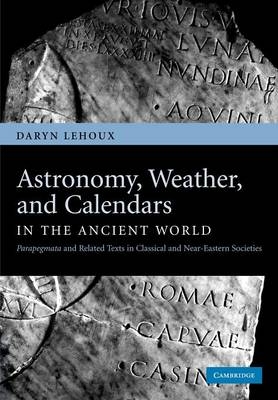
Astronomy, Weather, and Calendars in the Ancient World
Parapegmata and Related Texts in Classical and Near-Eastern Societies
Seiten
2012
Cambridge University Press (Verlag)
978-1-107-40477-9 (ISBN)
Cambridge University Press (Verlag)
978-1-107-40477-9 (ISBN)
A clear and accessible account of a set of popular instruments and texts (parapegmata) used in antiquity for astronomical weather prediction and the regulation of day-to-day life. For the first time the sources are presented in full, with an accompanying translation and a new and comprehensive analysis.
The focus of this book is the interplay between ancient astronomy, meteorology, physics and calendrics. It looks at a set of popular instruments and texts (parapegmata) used in antiquity for astronomical weather prediction and the regulation of day-to-day life. Farmers, doctors, sailors and others needed to know when the heavens were conducive to various activities, and they developed a set of fairly sophisticated tools and texts for tracking temporal, astronomical and weather cycles. Sources are presented in full, with an accompanying translation. A comprehensive analysis explores questions such as: What methodologies were used in developing the science of astrometeorology? What kinds of instruments were employed and how did these change over time? How was the material collected and passed on? How did practices and theories differ in the different cultural contexts of Egypt, Mesopotamia, Greece and Rome?
The focus of this book is the interplay between ancient astronomy, meteorology, physics and calendrics. It looks at a set of popular instruments and texts (parapegmata) used in antiquity for astronomical weather prediction and the regulation of day-to-day life. Farmers, doctors, sailors and others needed to know when the heavens were conducive to various activities, and they developed a set of fairly sophisticated tools and texts for tracking temporal, astronomical and weather cycles. Sources are presented in full, with an accompanying translation. A comprehensive analysis explores questions such as: What methodologies were used in developing the science of astrometeorology? What kinds of instruments were employed and how did these change over time? How was the material collected and passed on? How did practices and theories differ in the different cultural contexts of Egypt, Mesopotamia, Greece and Rome?
Part I. Parapegmata and Astrometeorology: 1. The rain in Attica falls mainly under Sagitta; 2. Spelt and Spica; 3. De signis; 4. When is thirty days not a month?; 5. Calendars, weather, and stars in Babylon; 6. Egyptian astrometeorology; 7. Conclusion; Part II. Sources: Catalogue of extant parapegmata; Extant parapegmata; Appendix 1. Authorities cited in parapegmata; Appendix 2. Tables of correspondence of parapegmata.
| Erscheint lt. Verlag | 19.7.2012 |
|---|---|
| Zusatzinfo | Worked examples or Exercises |
| Verlagsort | Cambridge |
| Sprache | englisch |
| Maße | 170 x 244 mm |
| Gewicht | 920 g |
| Themenwelt | Geschichte ► Allgemeine Geschichte ► Vor- und Frühgeschichte |
| Naturwissenschaften ► Geowissenschaften ► Meteorologie / Klimatologie | |
| Naturwissenschaften ► Physik / Astronomie ► Astronomie / Astrophysik | |
| ISBN-10 | 1-107-40477-0 / 1107404770 |
| ISBN-13 | 978-1-107-40477-9 / 9781107404779 |
| Zustand | Neuware |
| Haben Sie eine Frage zum Produkt? |
Mehr entdecken
aus dem Bereich
aus dem Bereich
auf den Spuren der frühen Zivilisationen
Buch | Hardcover (2023)
C.H.Beck (Verlag)
20,00 €
Konzepte – Methoden – Theorien
Buch | Softcover (2024)
UTB (Verlag)
39,90 €
Was Pompeji über uns erzählt
Buch | Hardcover (2023)
Propyläen (Verlag)
32,00 €


